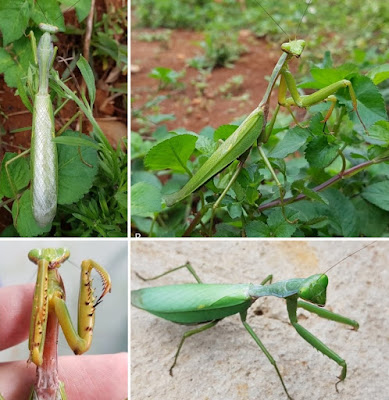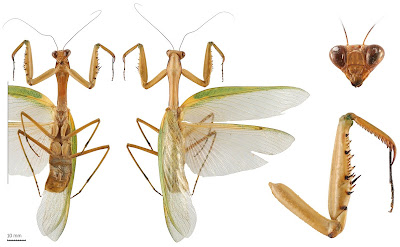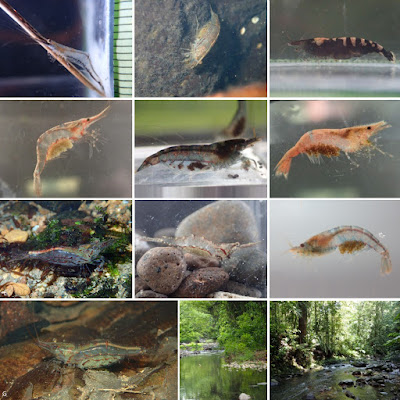[Most Recent Entries] [Calendar View]
Thursday, August 6th, 2020
| Time | Event | ||||
| 9:36a | [Entomology • 2020] Titanodula gen. nov. • A New Genus of Giant Oriental Praying Mantises (Mantodea: Mantidae: Hierodulinae) Abstract Recent taxonomic expeditions that were made possible within the framework of the Global Taxonomic Initiative project “A step further in the entomodiversity of Vietnam” resulted in the collecting of large and robust Hierodula-like praying mantises with a unique morphology of the male genitalia for which the new genus Titanodula gen. nov. is created. All collected specimens were very similar in external morphology, but an in-depth analysis of the male genitalia revealed the existence of two distinct species in Vietnam. One species was matched with Hierodula fruhstorferi Werner 1916, previously only known by the holotype female, hereby transferring it to Titanodula gen. nov. The other species is new to science, endemic to the Annamite mountain range in the Vietnamese Central Highlands, and is described as Titanodula attenboroughi sp. nov. in tribute to Sir. David Attenborough. Additionally, two other Oriental species, Hierodula grandis Saussure, 1870 and Hierodula formosana GiglioTos, 1912 are discussed and transferred to Titanodula gen. nov. Keywords: Annamite mountains, Global Taxonomic Initiative, Hierodula, Vietnam Taxonomy Order Mantodea Burmeister, 1838 Family Mantidae Burmeister, 1838 Subfamily Hierodulinae Brunner von Wattenwyl, 1893 Genus Titanodula gen. nov. Type species: Titanodula attenboroughi by present designation. DIFFERENTIAL DIAGNOSIS. Titanodula gen. nov. can be distinguished from all other genera within Mantidae by the combination of the following characters: 1) Large and robust praying mantis. 2) Lower frons with two vertical margins within, interrupted in the middle, forming two small but distinct tubercles at its anterior margin. 3) Ventral coxal lobe darkened or black ventrad. 4) Darkened or black spots at the base of 2nd, 10th and 15th profemoral AvS. 5) All protarsal segments black anteriorly. 6) Male genitalia as described below. ETYMOLOGY. The genus name is derived from the ‘Titans’ in Greek mythology, who were a mythological race of giants, thus emphasizing the large size and strength of the species belonging to this genus. The second part of the genus name “-dula” is a reference to the genus Hierodula in which some species were previously described. DISTRIBUTION. Titanodula gen. nov. has a confirmed presence in Bangladesh, Southern China, Taiwan and Vietnam. It appears that the genus has a wide distribution across the Oriental region but remains limited to suitable forested habitats, making these giant praying mantises vulnerable to habitat loss and deforestation as a result of expanding human activities. SPECIES INCLUDED: Titanodula attenboroughi sp. nov., Titanodula formosana (Giglio-Tos, 1912) comb. nov., Titanodula fruhstorferi (Werner, 1916) comb. nov. and Titanodula grandis (Saussure, 1870) comb. nov.
Titanodula attenboroughi sp. nov. DIAGNOSIS. Very large and robust praying mantis. Head triangular, antennae filiform. Long but robust pronotum, with smooth dorsal surface. Pronotum very finely denticulate along the margins of the prozone in female, without denticulations in the metazone, entirely smooth edges in males. Spinal formula: F = 4DS/15AvS/4PvS; T = 13−14AvS/10PvS. Ratios ♂: MzL/PzL: 3.2; ♀: MzL/PzL: 2.9. With black spots on the anterior side of the profemora located at the base of the 2nd, 10th and 15th anteroventral spine. Protarsus (all segments) entirely black on the anterior side. Both sexes macropterous. Phalloid apophysis (afa) with two sclerotised processes, anterior process (aafa) small and tubercle-shaped, broad and dome-like at the base with a smaller rounded projection on top of it, located posteriorly from the middle. Posterior process (pafa) spear-shaped, with weakly developed base, almost straight, long and heavily sclerotised, projecting straight or slightly diagonally posteriad. ETYMOLOGY. The species epithet is a patronym dedicated to Sir David Attenborough, one of the world's most beloved naturalists, in acknowledgment for his life-long endeavours to disseminate knowledge on all the beings that are part of the natural world and to advocate for their protection and conservation. DISTRIBUTION. Titanodula attenboroughi sp. nov. appears to be an endemic of undisturbed forests in the Vietnamese Annamite mountains. However, forests in the known distribution area are highly threatened and continue to disappear at an alarming rate. More distribution data are needed to evaluate the conservation status according to the IUCN Red Lists assessment guidelines, in the meanwhile the species is considered DD (Data Deficient). Xavier H.C. Vermeersch. 2020. Titanodula gen. nov., A New Genus of Giant Oriental Praying Mantises (Mantodea: Mantidae: Hierodulinae). Belgian Journal of Entomology. 100: 1–18. | ||||
| 10:21a | [Crustacea • 2020] Solomon’s Gold Mine: Description or Redescription of 24 Species of Caridina Freshwater Shrimps (Decapoda: Atyidae) from the Solomon Islands, including 11 New Species
Abstract Following recent (2014–2017) collections made in the Solomon Islands by the MNHN and the NGO ESSI, we provide a checklist of the species of amphidromous freshwater shrimps of the genus Caridina H. Milne Edwards, 1837 from this region. Using morphological as well as molecular data in an integrative taxonomic perspective, we found a total of 24 species, including 11 new for science, that are described or re-described, illustrated and discussed in relation to their habitat and distribution. Newly described species are Caridina barakoma sp. nov., C. choiseul sp. nov., C. intermedia sp. nov., C. maeana sp. nov., C. nana sp. nov., C. piokerai sp. nov., C. pisuku sp. nov., C. paratypus sp. nov., C. poarae sp. nov., C. sikipozo sp. nov. and C. turipi sp. nov. Caridina gueryi Marquet, Keith & Kalfatak, 2009 is re-validated as a species distinct from C. buehleri Roux, 1934. Lectotypes are designated for C. mertoni Roux, 1911 and C. papuana Nobili, 1905. Diagnoses for 6 informative species groups are provided: C. brevicarpalis group, C. gracilirostris group, C. nilotica group, C. typus group, C. serratirostris group and C. weberi group. A map of the species distribution in the Solomon Islands, as well as the phylogenetic relationships between the species and their relatives, are provided. Keywords. Amphidromous shrimp, Pacific Ocean, integrative taxonomy, morphology, 16S. Valentin de Mazancourt, David Boseto, Gerard Marquet and Philippe Keith. 2020. Solomon’s Gold Mine: Description or Redescription of 24 Species of Caridina (Crustacea: Decapoda: Atyidae) Freshwater Shrimps from the Solomon Islands, including 11 New Species. European Journal of Taxonomy. 696: 1–86. DOI: 10.5852/ejt.2020.696 |
| << Previous Day |
2020/08/06 [Calendar] |
Next Day >> |













